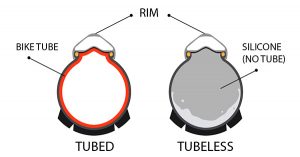Jim is an accomplished triathlete and endurance cyclist, and has raced in more than 35 USAT-certified races. He is also an avid trail runner and endurance gravel bike rider. Jim is a founder of Complete Tri and frequent writer on triathlon and cycling.
I’ve seen it all when it comes to bike tire problems. One of the most common issues that cyclists face is a tire that keeps going flat. If you’re frustrated with constantly having to pump up your tire or feeling like you’re always replacing or bike tires or bike inner tubes, don’t worry. In this blog post, I’ll share my expert advice on what you should do if your bike tire keeps going flat. Follow these suggestions, and you’ll be back on the road with a fully inflated tire in no time!
The tips below apply to both the Presta valve and Schrader valve.
What to do when your bike tire keeps going flat
Check for Debris or Sharp Objects
The first step in troubleshooting a flat tire is to inspect it thoroughly for any debris or sharp objects that may be causing the puncture. Small stones, thorns, glass, or even metal shards can easily lodge themselves into the tire tread and cause a slow leak. Carefully run your fingers along the inside and outside of the tire to feel for any foreign objects. If you find anything, use a pair of tweezers or pliers to remove it.
Pro Tip: If you frequently ride on rough terrains or gravel roads, consider investing in puncture-resistant tires that are designed to minimize the risk of flat tires caused by debris.
Inspect the Rim Tape
 The rim tape is a crucial component that lines the inside of the rim and protects the inner tube from rubbing against the spoke holes or sharp edges of the rim. If the rim tape is damaged or misaligned, it can cause the inner tube to puncture. Carefully remove the tire and inspect the rim tape for any signs of wear and tear, such as cracks, holes, or frayed edges. If you notice any issues, replace the rim tape immediately to ensure proper protection for your inner tube.
The rim tape is a crucial component that lines the inside of the rim and protects the inner tube from rubbing against the spoke holes or sharp edges of the rim. If the rim tape is damaged or misaligned, it can cause the inner tube to puncture. Carefully remove the tire and inspect the rim tape for any signs of wear and tear, such as cracks, holes, or frayed edges. If you notice any issues, replace the rim tape immediately to ensure proper protection for your inner tube.
Pro Tip: Use high-quality rim tape that is the correct width for your rim to prevent flats caused by rim tape failure. It’s worth investing in a durable and reliable rim tape to avoid frequent tire issues.
Check for Pinch Flats
Pinch flats, also known as snake bites, occur when the tire gets compressed between the rim and an obstacle, causing two punctures on the inner tube. This type of flat tire is often caused by hitting a pothole or curb at high speed, or insufficient tire pressure. To check for pinch flats, remove the tire and inspect the inner tube for two parallel punctures that are typically close together. If you suspect pinch flats, make sure to inflate your tire to the recommended pressure before reinstalling it to prevent future occurrences.
Pro Tip: Always maintain the proper tire pressure recommended by the manufacturer to prevent pinch flats and other tire-related issues. Invest in a reliable bike pump with a pressure gauge to ensure accurate inflation.
Inspect the Tire for Cuts or Tears
Sometimes, the culprit behind a flat tire is a cut or tear on the tire itself. Inspect the tire tread and sidewalls carefully for any visible cuts, tears, or punctures. If you notice any damage, the tire may need to be replaced, as it can cause repeated flats. Small cuts or punctures can often be repaired with a patch kit, but larger cuts or tears may require a new tire.
For somebody who is riding on a mountain bike or riding a gravel bike on rougher terrain, the chance for a puncture can come from all directions.

Pro Tip: Avoid riding over sharp objects or rough surfaces that can cause cuts or tears in the tire. Also, regularly inspect your tires for wear and replace them when they show signs of damage or excessive wear.
Check Your Valve Cores
The valve and valve core are crucial components that play a role in maintaining proper tire inflation. A faulty valve or valve core can cause air to leak from the tire, resulting in repeated flats. Inspect the valve for any signs of damage, such as cracks or corrosion. If the valve appears to be in good condition, check the valve core to ensure it is tightened securely. Sometimes, a loose or faulty valve core can be the culprit behind a slowly deflating tire. Use a valve core tool to tighten or replace the valve core if necessary.
Pro Tip: Regularly inspect and maintain your tire valves and valve cores to prevent air leaks and flat tires. Consider investing in high-quality valve cores that are known for their durability and reliability. Also, carry a valve core tool and spare valve cores on your bike rides for quick repairs on the go.
Check for Small Rocks Inside Your Tire (against the tube)
Another potential cause of repeated flat tires is debris or small rocks that may have lodged between the tire and the tube. These foreign objects can puncture the tube, causing slow leaks and flat tires. Inspect the entire circumference of the tire carefully, and remove any debris or rocks that you find. Use a tire lever or your fingers to gently pry out any lodged objects, being careful not to damage the tire or tube in the process. Even if you replace a tube, it can be easy to miss a small stone rolling around inside your tire, which will probably puncture the next tube you put on it. Once you have removed all debris, inflate the tire and check for any remaining leaks.
Pro Tip: To minimize the risk of debris getting lodged between your tire and tube, consider using tire liners or tire sealants. Tire liners are protective strips that can be inserted between the tire and tube to provide an extra layer of defense against punctures. Tire sealants, on the other hand, are liquid solutions that can be added to the tube or tire and seal small punctures on the go. These products can help prevent flats caused by small rocks or debris, and provide added peace of mind during your rides.
Also, be sure that you always replace your tubes and install new tiers in the cleanest place possible, to avoid the risk of getting debris inside the tire.
Consider Going Tubeless
If you’re constantly dealing with flat tires due to rough roads or thorny terrains, one solution you may want to consider is going tubeless. Tubeless bike tires are a popular choice among off-road cyclists and mountain bikers as they are less prone to flats caused by punctures. Tubeless tires work by eliminating the need for an inner tube, and instead, use a special airtight tire and rim combination, along with sealant to keep the tire inflated.
With tubeless tires, you won’t have to worry about pinch flats or punctures caused by small debris, as the sealant in the tire can quickly seal most small holes, allowing you to keep riding without interruptions. While the initial setup of tubeless tires can be a bit more involved than traditional tires, the benefits of reduced flats and increased performance can be well worth it for riders who frequently encounter flat tire issues.
Pro Tip: When converting to tubeless tires, make sure to follow the manufacturer’s instructions carefully for proper installation and maintenance. Use the recommended tubeless tires, rims, and sealant for best results. It’s also a good idea to carry a tubeless repair kit and spare sealant on your rides for quick fixes in case of larger punctures.
Bike Tire Flat FAQs
How many bike flats are considered normal?
The frequency of bike flats can vary depending on factors such as the type of terrain you ride on, tire quality, and maintenance practices. However, it’s generally not considered normal to experience frequent flat tires. With proper tire maintenance, including regular inspections, inflation at the correct pressure, and avoiding debris, you can minimize the occurrence of flats.
If you have a tire that keeps going flat every few days or even weeks, something is probably wrong with it.
Do tubeless tires help minimize flats?
Yes, tubeless tires can be an effective way to minimize flats, especially if you ride on rough terrain or encounter debris frequently. Tubeless tires eliminate the need for an inner tube and use sealant to quickly seal punctures, reducing the risk of flats caused by small debris or rocks. Tubeless tires can also be ridden at lower PSI, and because there is not tube, there will be no pinch flats. However, proper installation and maintenance are crucial for optimal performance, so it’s important to follow the manufacturer’s instructions carefully.
Can I repair a flat tire myself?
Yes, repairing a flat tire is a common bike maintenance task that can be done by most cyclists with basic tools and skills. It doesn’t take long to change a bike tire once you become adept at it. However, it’s important to properly identify the cause of the flat, such as a puncture or pinch flat, and follow the correct repair procedures. It’s also essential to carry a spare tube, tire levers, and a pump or CO2 cartridge for on-the-go repairs.
Should I replace my tire after it goes flat multiple times?
It depends on the condition of the tire. If the tire has been repeatedly patched or has significant cuts or tears, it may be time to replace it. Multiple flats can weaken the tire, making it more prone to future flats. Additionally, if the tire has reached its recommended mileage or is showing signs of significant wear, it’s best to replace it to ensure safe and reliable cycling.
When should I seek help from a professional bike mechanic?
If you’re unsure about the cause of repeated flats, don’t have the necessary tools or skills for tire repairs, or if you notice any significant damage to your tire or rim, it’s best to seek help from a professional bike mechanic. They can provide expert advice and ensure that your bike is properly repaired and safe to ride.







